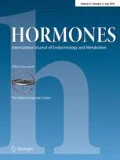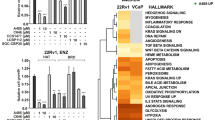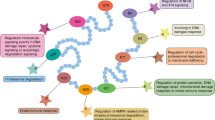Abstract
Background
The progression of endometrial cancer (EC) is closely related to estrogen levels. UDP-glucuronosyltransferases (UGTs) are an essential class of phase II metabolizing enzymes that play a pivotal role in detoxifying steroid hormone.
Purpose
In this study, we aimed to uncover the role of UGTs in estrogen metabolism and the pathogenesis of EC.
Methods
A total of 100 unrelated EC patients (mean age 52.15 ± 10.04 y) and 100 healthy subjects (mean age 50.26 ± 8.80 y) were recruited for analysis of the UGT gene polymorphism and estrogen level. In six cases of EC, EC-adjacent tissues and cancer tissues were collected for detection of UGT expression.
Results
Our results showed that the estrogen homeostasis profile was disturbed in EC patients, with carcinogenic catechol estrogens (4-OHE1, 2-OHE1, 2-OHE2) significantly accumulated in the serum of these patients. Also, levels of estrogen-glucuronides were decreased significantly, and the expression of UGT1A8 and UGT2B7 in uterine tissues was downregulated in EC patients. Consistent with this, we observed that the distribution of genotypes and allele frequencies in UGT1A8 rs1042597 and UGT2B7 rs7439366 was significantly different between EC patients and healthy volunteers.
Conclusion
These results indicated that UGT1A8 and UGT2B7 may contribute to the estrogen signaling pathway and the pathogenesis of EC.



Similar content being viewed by others
References
Busch EL, Crousbou M, Prescott J, Chen MM, Downing MJ, Rosner B et al (2017) Endometrial cancer risk factors, hormone receptors, and mortality prediction. Cancer Epidemiol Biomark Prev 26:727–735
Eliassen AH, Spiegelman D, Xu X, Keefer LK, Veenstra TD, Barbieri RL et al (2012) Urinary estrogens and estrogen metabolites and subsequent risk of breast cancer among premenopausal women. Cancer Res 72:696–706
Hawsawi Y, Elgendy R, Twelves C, Speirs V, Beattie J (1836) Insulin-like growth factor — oestradiol crosstalk and mammary gland tumourigenesis. Biochim Biophys Acta 2013:345–353
Zhou X, Zhao Y, Wang J, Wang X, Chen C, Yin D et al (2018) Resveratrol represses estrogen-induced mammary carcinogenesis through NRF2-UGT1A8-estrogen metabolic axis activation. Biochem Pharmacol
Newbold RR, Liehr JG (2000) Induction of uterine adenocarcinoma in CD-1 mice by catechol estrogens. Cancer Res 60:235–237
Sampson JN, Falk RT, Schairer C, Moore SC, Fuhrman BJ, Dallal CM et al (2016) Association of estrogen metabolism with breast cancer risk in different cohorts of postmenopausal women. Cancer Res 77:918
Walia G, Smith AD, Riches Z, Collier AC, Coughtrie MWH (2017) The effects of UDP-sugars, UDP and Mg2+on uridine diphosphate glucuronosyltransferase activity in human liver microsomes. Xenobiotica:1–9
Zhou X, Zheng Z, Xu C, Wang J, Min M, Zhao Y et al (2017) Disturbance of mammary UDP-glucuronosyltransferase represses estrogen metabolism and exacerbates experimental breast cancer. J Pharm Sci 106:2152–2162
Guillemette C, Belanger A, Lepine J (2004) Metabolic inactivation of estrogens in breast tissue by UDP-glucuronosyltransferase enzymes: an overview. Breast Cancer Res 6:246–254
Thibaudeau J, Lépine J, Tojcic J, Duguay Y, Pelletier G, Plante M et al (2006) Characterization of common UGT1A8, UGT1A9, and UGT2B7 variants with different capacities to inactivate mutagenic 4-hydroxylated metabolites of estradiol and estrone. Cancer Res 66:125–133
Lehmann L, Wagner J (2008) Gene expression of 17beta-estradiol-metabolizing isozymes: comparison of normal human mammary gland to normal human liver and to cultured human breast adenocarcinoma cells. Adv Exp Med Biol 617:617–624
Motaghed M, Alhassan FM, Hamid SS (2014) Thymoquinone regulates gene expression levels in the estrogen metabolic and interferon pathways in MCF7 breast cancer cells. Int J Mol Med 33:8–16
Haakensen VD, Biong M, Lingjaerde OC, Holmen MM, Frantzen JO, Chen Y et al (2010) Expression levels of uridine 5′-diphospho- glucuronosyltransferase genes in breast tissue from healthy women are associated with mammographic density. Breast Cancer Res 12:1–11
Hu XM, Liu YN, Zhang HL, Cao SB, Zhang T, Chen LP et al (2015) CXCL12/CXCR4 chemokine signaling in spinal glia induces pain hypersensitivity through MAPKs-mediated neuroinflammation in bone cancer rats (Retracted article. See vol. 141, pg. 473, 2017). J Neurochem 132:452–463
Cui G, Yang X, Wang X, Zhang Z, Yue X, Shi H et al (2014) Ranitidine reduced levodopa-induced dyskinesia in a rat model of Parkinson’s disease. Neuropsychiatr Dis Treat 10:39–46
Xia X, Keefer LK, Ziegler RG, Veenstra TD (2007) A liquid chromatography-mass spectrometry method for the quantitative analysis of urinary endogenous estrogen metabolites. Nat Protoc 2:1350–1355
Jiang H, Sun J, Chen Y, Song Y, Dong L, Zhan Q et al (2012) Analysis of multiplex endogenous estrogen metabolites in human urine using ultra-fast liquid chromatography–tandem mass spectrometry: a case study for breast cancer. Anal Chim Acta 711:60–68
Wan J, Yin Y, Zhao M, Shen F, Chen M, Chen Q (2017) The positivity of G-protein-coupled receptor-30 (GPR 30), an alternative estrogen receptor is not different between type 1 and type 2 endometrial cancer. Oncotarget 8:90897–90904
Ning C, Xie B, Zhang L, Li C, Shan W, Yang B et al (2016) Infiltrating macrophages induce ERα expression through an IL-17A-mediated epigenetic mechanism to sensitize endometrial cancer cells to estrogen. Cancer Res
Dovnik A, Crnobrnja B, Zegura B, Takac I, Pakiz M (2017) Incidence of positive peritoneal cytology in patients with endometrial carcinoma after hysteroscopy vs. dilatation and curettage. Radiol Oncol 51:88–93
Centrella M, Mccarthy TL (2012) Estrogen receptor dependent gene expression by osteoblasts - direct, indirect, circumspect, and speculative effects. Steroids 77:174–184
Adjei AA, Weinshilboum RM (2002) Catecholestrogen sulfation: possible role in carcinogenesis. Biochem Biophys Res Commun 292:402–408
Cuzick J, Sestak I, Baum M, Buzdar AU, Howell A, Dowsett M et al (2010) Effect of anastrozole and tamoxifen as adjuvant treatment for early-stage breast cancer: 10-year analysis of the ATAC trial. Lancet Oncol 11:1135–1141
De Velde CJHV, Rea D, Seynaeve C, Putter H, Hasenburg A, Vannetzel JM et al (2011) Adjuvant tamoxifen and exemestane in early breast cancer (TEAM): a randomised phase 3 trial. Lancet 377:321–331
Hallum S, Pinborg A, Kamperjørgensen M (2016) Long-term impact of preeclampsia on maternal endometrial cancer risk. Br J Cancer 114:809–812
Chlebowski RT, Anderson GL, Sarto GE, Haque R, Runowicz CD, Aragaki AK et al (2016) Continuous combined estrogen plus progestin and endometrial cancer: The Women’s Health Initiative randomized trial, J Natl Cancer Inst. 108:djv350
Zhao H JY, Liu Y, et al2015. Endogenous estrogen metabolites as biomarkers for endometrial cancer via a novel method of liquid chromatography-mass spectrometry with hollow fiber liquid-phase microextraction ;47:158–64
Mostaghel EA, Zhang A, Plymate SR (2016) UDP-glucuronosyltransferase enzymes in prostate cancer progression: is only androgen catabolism involved? Eur Urol 69:610–612
Turgeon D, Carrier J, Levesque E, Hum DW, Belanger A (2001) Relative enzymatic activity, protein stability, and tissue distribution of human steroid-metabolizing UGT2B subfamily members. Endocrinology 142:778–787
Gestl SA, Green MD, Shearer DA, Frauenhoffer E, Tephly TR, Weisz J (2002) Expression of UGT2B7, a UDP-glucuronosyltransferase implicated in the metabolism of 4-hydroxyestrone and all-trans retinoic acid, in normal human breast parenchyma and in invasive and in situ breast cancers. Am J Pathol 160:1467–1479
Hevir N, Sinkovec J, Rižner TL (2011) Disturbed expression of phase I and phase II estrogen-metabolizing enzymes in endometrial cancer: lower levels of CYP1B1 and increased expression of S-COMT. Mol Cell Endocrinol 331:158–167
Yang HP, Jesus GB, Qizhai L, Platz EA, Brinton LA, Sherman ME et al (2010) Common genetic variation in the sex hormone metabolic pathway and endometrial cancer risk: pathway-based evaluation of candidate genes. Carcinogenesis 31:827
Thibaudeau J, Lépine J, Tojcic J, Duguay Y, Pelletier G, Plante M et al (2006) Characterization of common UGT1A8, UGT1A9, and UGT2B7 variants with different capacities to inactivate mutagenic 4-hydroxylated metabolites of estradiol and estrone. Cancer Res 66(1):125–133
Duguay Y, Mcgrath M, Lepine J, Gagne J, Hankinson SE, Colditz GA et al (2004) The functional UGT1A1 promoter polymorphism decreases endometrial cancer risk. Cancer Res 64:1202–1207
Megumi Y, Akira H, Kazuya M, Tomoko A, Kensuke S, Takeshi M et al (2015) Polymorphisms of estrogen metabolism-related genes ESR1, UGT2B17, and UGT1A1 are not associated with osteoporosis in surgically menopausal Japanese women. Przegla̜d Menopauzalny = Menopause Review 14:161–167
Tang L, Platek ME, Yao S, Till C, Goodman PJ, Tangen CM et al (2018) Associations between polymorphisms in genes related to estrogen metabolism and function and prostate cancer risk: results from the Prostate Cancer Prevention Trial. Carcinogenesis 39
Hu DG, Mackenzie PI, Mckinnon RA, Meech R (2016) Genetic polymorphisms of human UDP-glucuronosyltransferase (UGT) genes and cancer risk. Drug Metab Rev 48:47–69
Funding
This study was supported by the Graduate Student Research Innovation Projects in Jiangsu Province (KYCX18_2199); the Natural Science Foundation of the Jiangsu Higher Education Institutions of China (No. 18KJA350002); the Natural Science Foundation of Jiangsu Province (No. BK20181470, No. BK20161179); the Science and Technology Foundation of Xuzhou (No. KC18044); the Natural Science Foundation of China (No. 81403001); the special financial grant from the China Postdoctoral Science Foundation (No. 2016T90510); the China Postdoctoral Science Foundation funded the project (No. 2015 M580474); the Six Talent Peaks Project in Jiangsu Province (YY-045); the Qing Lan Project in Jiangsu Province and a project funded by the Priority Academic Program Development of Jiangsu Higher Education Institutions (PAPD).
Author information
Authors and Affiliations
Contributions
XYZ and FZ contributed to the conception and design. FZ, XYZ, and XW performed the methodology. FZ, YW, and RL collected experimental data. FZ and XW analyzed and explained the data. FZ and XYZ wrote, reviewed, and revised the manuscript. XYZ, YW, BZ, and JBZ contributed to the administrative, technical, and material support. XYZ supervised the research. All authors read and approved the final manuscript.
Corresponding author
Ethics declarations
Conflict of interest
The authors declare that they have no competing interests.
Ethical approval
All procedures performed in studies involving human participants were in accordance with the ethical standards of the institutional and/or national research committee and with the 1964 Declaration of Helsinki and its later amendments or comparable ethical standards. This study is registered on the Clinical Test Public Management Platform (Registration number: ChiCTR1800014658).
Informed consent
Informed consent was obtained from all individual participants included in the study.
Additional information
Publisher’s note
Springer Nature remains neutral with regard to jurisdictional claims in published maps and institutional affiliations.
Rights and permissions
About this article
Cite this article
Zhao, F., Wang, X., Wang, Y. et al. The function of uterine UDP-glucuronosyltransferase 1A8 (UGT1A8) and UDP-glucuronosyltransferase 2B7 (UGT2B7) is involved in endometrial cancer based on estrogen metabolism regulation. Hormones 19, 403–412 (2020). https://doi.org/10.1007/s42000-020-00213-x
Received:
Accepted:
Published:
Issue Date:
DOI: https://doi.org/10.1007/s42000-020-00213-x




